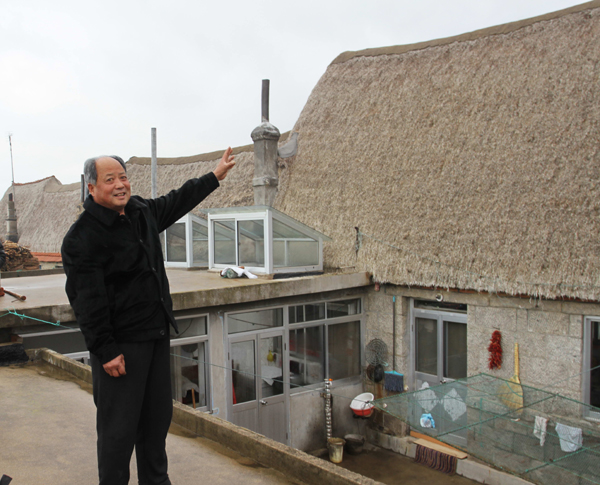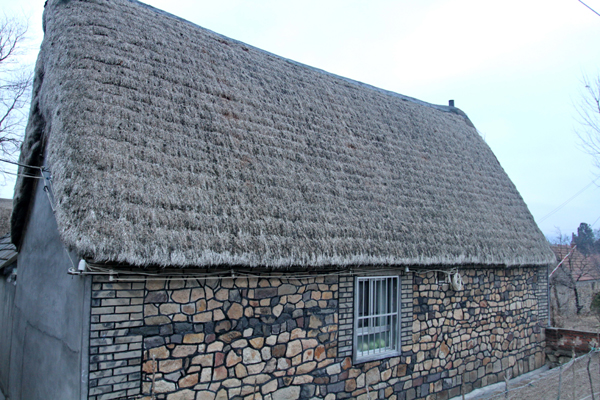According to Zhang Qishuai, vice director of the Information Office of Rongcheng City, the seaweed houses were built in the Qin and Han dynasties. They were widespread in the coastal areas of Jiaodong during the Song Dynasty. There are now a total of 20,000 households living in them, with more than 90,000 rooms in Rongcheng, 317 of which were built in the Yuan, Ming, and Qing Dynasties.
Rongcheng is located in the coastal areas, which are rainy in summer, and snowy and cold in winter. The seaweed houses are adapted to the coastal climate, because wild seaweed contains colloid and a lot of salt. It is mothproof, and rarely suffers from mildew or fire. They are warm in winter and cool in summer, and favored by local residents.
 |
|
A villager surnamed Yu told the reporter that his seaweed house is very comfortable. |
Yu Yingyu, a local folklore researcher, said that seaweed houses' roofs can last up to 50 years. In Ningjin village, an existing seaweed house has a history of more than 300 years. In Weiwei village of Gangxi town, there are more than 20 seaweed houses with a history of more than 200 years. In Rongcheng there are seven seaweed house villages with more than a century of history which were named "national traditional villages".
Bi Yuanmou, 83, a local in Dongchudao village, said that a seaweed house requires more than 5,000 kg of seaweed to build. "Now, young people like to live in the new tile houses, but the elderly still live in the old houses," he said. "The old houses, which have refrigerators, gas, solar water heaters inside, are very convenient."
"It requires 70 steps to build a seaweed house, and it has to be done by hand," said Liu Yuqi, a seaweed house maker in Weiwei village. It requires three or four people to spend 10 days building a seaweed house. In 2006, the seaweed house making techniques were included in the Shandong provincial "intangible cultural heritage" list.
 |
|
A seaweed house made with irregular localstones and dried seaweed. The layer of thatch at a 50 degree angle which makes up the herringbone sloping roof, has a thickness of between 1 to 4 meters. The towering seagrass roof looks like a big hat. |
"Today's young people tend to work in the city. Only a very few people are willing to learn the craft. Fewer and fewer people can build a seaweed house," Liu Yuqi said.
Dongchudao village, in the Wanli of the Ming Dynasty, had 144 well-preserved ancient seaweed houses. In 2007, it was named a "Chinese historical and cultural village" by the State Ministry of housing and the State Administration of Cultural Relics Bureau.
The seaweed house is one of the most representative ecological dwellings along the Chinese coast. It represents the architectural heritage and folklore of the coast of the Jiaodong peninsula, and is an important source for the study of ancient coastal dwellings and folk culture. Rongcheng seaweed houses have been featured in the "Chinese folk houses" series of stamps in the early 1990s.
It is disheartening to see that many seaweed houses have not been repaired for years because villagers have moved into the town. According to Qiao Wenjiang, director of Rongcheng cultural relic bureau, many measures have been taken by the local government to protect the ancient houses. Rongcheng seaweed houses have been included in the Shandong Province's "rural memory project" and money is allocated to repair them every year.
The local government is also actively developing ecological village tourism. In Jiayuwang village, 17 seaweed houses are used to attract tourists, where they can live and experience the traditional fishing life. In Yandunjiao village, there are more than 40 restaurants, photography reception stations and Seaweed House Hotels, which receive tens of thousands of visitors annually and bring in almost 10 million yuan in revenue.
The prosperity brought by the tourism industry gives new life to the ancient seaweed houses.